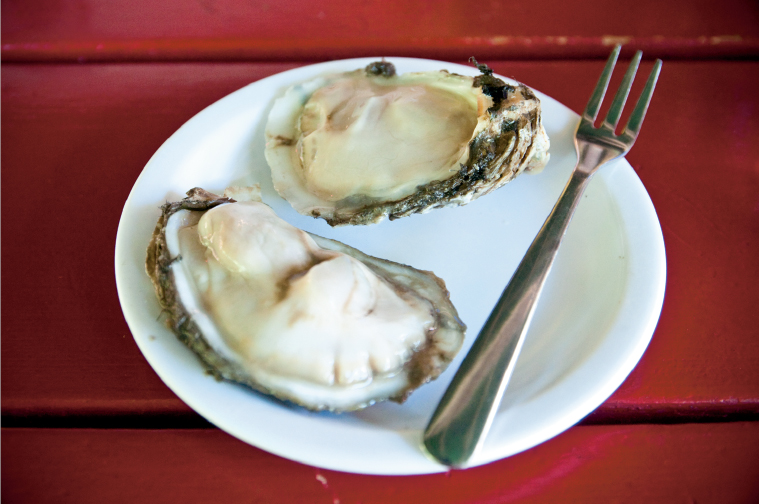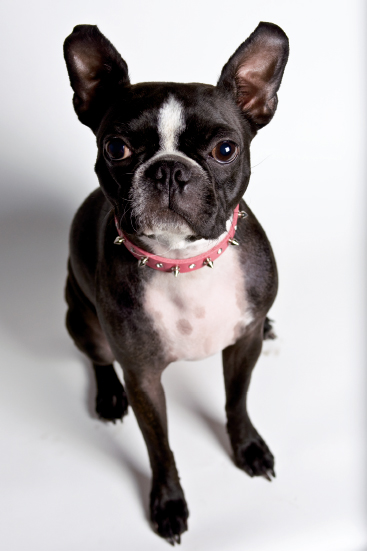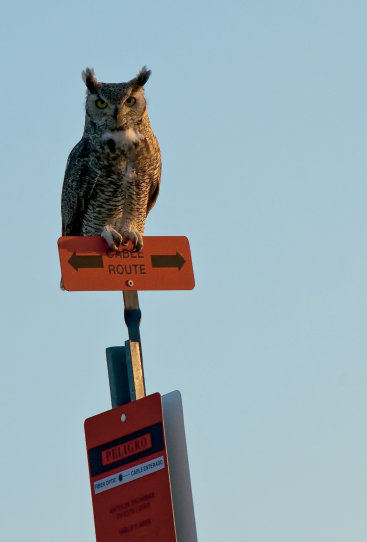CHAPTER 15
Stock Photography
Almost everyone who puts a substantial amount of money into cameras and lenses would like to recoup their investment. Becoming a full-time professional may not be in your plans, but there are ways to make a little money in photography. One of these ways is by selling stock photography. Making and selling stock photography can be as easy as taking photos on your family vacation or as ambitious as hiring models, finding sets, and creating your own photographic scenarios.

Nearly any type of image can be used for stock photography. Exposure: ISO 1200, f/2.8, 1/200 second using a Nikon 35mm f/1.8G lens.
Stock Photography Overview
What exactly is stock photography? Stock photography can encompass every type of photography that's out there, but the short answer is that stock photography is a collection of images that is available to art directors, editors, and advertising agencies for use in books, magazines, ad campaigns, brochures, or thousands of other mediums ranging from print to Web. A buyer can purchase these images outright for a one-time fee and use them however she wants for however long she sees fit (royalty-free), or they can be leased for a usage fee (rights-managed). This section explains the different types and uses of stock photography.
Basically there are two different types of uses for stock photography: creative and editorial. Creative stock photography is generally used for advertising campaigns and almost anything that has to do with business, from mailers and pamphlets to billboards. Editorial stock photography generally includes current event, entertainment, documentary, and even archival photographs. Editorial stock is used for mostly magazines, books, and sometimes television or film documentaries.
Creative stock
Creative stock photography is usually conceptual. The photographer conceives of an image and specifically sets out to photograph it. This can be anything from a still-life setup to a lifestyle or animal shot. Lifestyle photography is probably the most lucrative form of stock photography out there right now and lifestyle shots can be used for almost anything. The goal of creative stock is ultimately to sell a product.
Lifestyle photography
Lifestyle photography is a loosely interpreted term that can mean almost anything. The general goal of lifestyle photography is to show a brand style or attitude. It most often features people or groups of people in settings where there is some sort of staged action (typically intended to appear as if it were not staged). Think of the ads that come with the Sunday morning paper. If the merchant is selling sports clothing, you might see a group of guys hanging out, holding some sort of sporting equipment, be it a football, a hockey stick, or something sports related. Lifestyle photography can feature families, medical personnel, or even extreme sports types. Essentially this form of photography uses imagery that certain types of people can identify with and may or may not feature an actual product.
Basically, the process for taking lifestyle photographs is as follows:
- Conceive of an idea. This is basically where you come up with a concept. Think of activities or events like a trip to the beach, moving into a new house, gardening, and so on.
- Make a shot list. Take the idea and think of what would be happening for the concept. For example, when new occupants move into a new house, you might see them unpacking moving boxes, painting, or putting up shelves. A shot list should consist of a number of different shots and you can list what kind of angles you want, the depth of field effect you're after, or other notes.
- Get the pieces into place. Find or build a set, hire models, and piece together the wardrobe and props.
- Shoot. Pose the models, position the props, set up the lighting, and shoot the photos.
- Edit. Edit out the weakest images and post-process the ones that you have selected as keepers.
Lifestyle photography is an ambitious endeavor and can get very expensive if you want to make a serious go of it. Of course you can make it much simpler and do smaller shoots, but the more styles and scenes you have, the more likely you will be to sell your images.
Figure 15.1 shows a typical lifestyle shot. This shot was a simple setup consisting of a model enjoying a cup of coffee in a coffee shop. It portrays the easygoing lifestyle of a young urbanite.

15.1 This figure shows a typical lifestyle shot. Exposure: ISO 1600, f/5.6, 1/400 second using a 35mm f/1.8G lens.
Product/Still-life
Although more often than not lifestyle photography has people in it, you don't necessarily need people to portray a lifestyle. Often you can portray a lifestyle simply by making a still-life setup that evokes a feeling or an attitude. Figure 15.2 is a stock photography shot that evokes a feeling of nostalgia by featuring a vintage-style microphone in the forefront and a vintage guitar and amplifier implied in the background, recognizable even though they are blurred by the shallow depth of field.
For this shot I used an off-camera SB-600 triggered by the built-in flash to add highlights to the chrome microphone. The flash was set to TTL (Through-the-Lens) with –0.7 FEC.
Although it's probably less lucrative than traditional lifestyle photography, this type of photography is much more accessible for most people. All you really need is a good concept and a few props.

15.2 This figure shows a still-life stock photography shot. Exposure: ISO 400, f/3.2, 1/60 second using a Nikon 28mm f/2.8D lens.
Animals
There are also quite a few stock agencies that deal with pet and animal photography. More often than not they are looking for clean pet portrait shots done on a plain background to allow ad agencies to drop in type or another background if desired.
Figure 15.3 is a stock shot of my dog Henrietta. This shot was very easy to execute and when setting up this type of shot, you can get a variety of different shots by adding props or different poses. I've seen shots similar to this one at stock photo Web sites that feature dogs with party hats, wigs, bones, and many other types of props. For this shot I simply used a piece of white poster board for the backdrop. I used the built-in flash to trigger an off-camera SB-800 that was diffused by using a Photoflex LiteDome XS softbox. This softbox was specifically made for use with off-camera Speedlights. It's great for a portable studio and enables you to get pro-quality lighting for a small amount of money.
A good idea for shooting pets and animals is to keep some treats on hand. It also helps to work with animals that have had a little training.

15.3 This figure shows a stock shot of a Boston Terrier. The model is my dog Henrietta. Exposure: ISO 200, f/5.6, 1/200 using a Nikon 28-70mm f/2.8D lens at 40mm.
Editorial stock
Editorial stock photography is used for books, magazines, and newspapers. Editorial stock isn't used for selling a product but for illustrating a story or simply showing what has happened in a current event. This type of photography is usually conceptual and includes photographs by famous photographers; for example the stock photography agency Corbis Images deals with the licensing of images by famous photographers Ansel Adams and Brett Weston.
Documentary
Documentary stock photography consists of a multitude of different subjects. Food, travel, nature, wildlife, science, and technology are just some examples. These images are often used in feature stories of magazines and newspapers when the articles are not considered news or current events. Almost any image can be used as a documentary type of stock photograph because the topics can be so varied.
Current events and entertainment
Current events and entertainment photography is pretty self-explanatory. It ranges from newsworthy events such as politicians' speeches, movie premieres, sports, concerts, and other similar types of events. This is the type of stock photography I do the most of for my agency, Corbis Images.
This type of photography can be hit or miss. Some events require a press pass, but some events you can just show up and shoot. Check the local paper for things like movie premiers, charity events, and political rallies. All these events are great for current events photos.
Figure 15.5 is a shot of NBA star LeBron James and rapper Jay-Z at a charity event. When images of this type are placed with a stock agency, trade magazines or sports and celebrity Web sites will pick them up.

15.4 This stock image of a great horned owl was used to illustrate a story about the plight of the owls as civilization encroaches on their habitat. Exposure: ISO 320 (Auto ISO), f/7.1, 1/350 second using a Nikon 80-200mm f/2.8D lens.
Stock Photography Licensing
As I touched on earlier, two distinctly different types of licensing are available to those purchasing stock images: royalty-free and rights-managed. The licensing largely depends on what the image is going to be used for. Typically, this part of the stock photography business is handled by the agency unless the photographer is acting as his own agent. What does licensing mean exactly? It means that you own your images and you grant the right to use them to a buyer for specific applications and lengths of time. The price is usually determined by a number of factors, which are explained in the following sections.
Royalty-free
This is probably the cheapest way to obtain an image. Royalty-free doesn't exactly mean that people are free to use the image as they see fit. The buyer must pay for the image. The payment is a one-time fee that allows the purchaser of the image to use it multiple times without paying additional royalties to the copyright owner.
One of the most attractive things about royalty-free images to buyers is that the price is generally based on file size, meaning that if the buyer wants to use it on a blog at 72 dpi (dots per inch), the image is usually very cheap, and if the buyer wants to use it on the Web for 1,000 blogs, she doesn't need to pay additional fees.

15.5 This figure shows a typical current events stock shot. Exposure: ISO 1100 (Auto ISO), f/4, 1/125 second using a Nikon 17-55mm f/2.8G lens at 17mm.
One of the downsides to royalty-free images (for the buyer at least) is that the images are usually licensed under what's known as a nonexclusive license, meaning that same image could be licensed to a competitor and used for the same application. This is an upside to the photographer because multiple small fees for an image can make almost as much (sometimes more) money than a one-time more-expensive fee for exclusive licensing.
Rights-managed
Rights-managed images get more “bang for the buck” for both the photographer and the buyer than royalty-free images. Licensing these types of images costs more than the royalty-free photos. The price is determined by quite a few factors, which usually include, but aren't limited to
- Usage. This is what the image is going to be used for. It could be print advertising, such as on a billboard or in a magazine ad; corporate imagery, such as in the company newsletter or Web site; or editorial content, such as in a newspaper article. Generally any type of national or international use is the most lucrative.
- Size. This is self-explanatory; obviously a billboard-sized image is worth more than a postage stamp-sized image buried in the back pages of the Sunday paper.
- Print run. This refers to how many copies of the photos are going to be printed for the specific usage. For example, a small local paper will have a print run of a few thousand papers whereas a national magazine will print a million or more magazines. Of course, the larger the print run, the larger the fee.
- Duration. This is how long the image will be displayed. For example, it might appear in a daily newspaper, a bimonthly magazine, or a recurring ad campaign.
- Geographical location. This refers to the specific country or region where the image will be used. For example, if the image will be used nationwide, it will be worth more than if it's going to be used in a small town.
- Exclusivity. Rights-managed images aren't necessarily exclusive. The buyer is usually guaranteed that the image won't be used by a competitor or in the same geographical location, though it truly depends on the contract. Exclusive images command a higher price due to the fact that they cannot be used by multiple parties, which limits the income the photographer can earn from the particular image.
A lot of other factors go into determining the price, including the amount of images, whether the buyer has purchased images previously, and the current market rate, among other things.
Breaking into the Market
If this sounds good to you, then you're probably asking, “Where do I sign up?” Well, it's not just as easy as putting your images up online, although that's one way to approach it. Of course, you can design a Web site and put up all your photographs and hope that a photo buyer stumbles across them and buys some. This is akin to the photo buyer finding a needle in a haystack. What you need is marketing.
At one time, stock photography was a thriving business with many different agencies representing the work of a select number of professional photographers. With the advent of digital photography and, subsequently, the affordability of pro-level dSLR cameras, the industry was turned on its head. In the '90s, as digital photography boomed and the Internet made it easy to browse images online, two companies began buying out the smaller companies and enveloping them in their maw to create two huge stock photography agencies: Getty Images and Corbis Images (owned by Microsoft's Bill Gates). My work is licensed through Corbis, which has helped place my images in many national and international outlets.
These agencies handle marketing as well as negotiating the sale of the image, leaving you free to create your photos. This does come at a cost. First, the agency usually sets the price of your images. Second, the agency takes a cut, usually to the tune of 50 percent. That's a pretty small price to pay for national exposure, though.
![]() Micro-stock agencies generally keep between 60-80 percent of the royalty fees of each image sold.
Micro-stock agencies generally keep between 60-80 percent of the royalty fees of each image sold.
The best situation would be to sign a contract with one of the super-agencies. This is where the national magazines and ad agencies shop. It's actually pretty simple to apply to them, but you need a top-notch portfolio and usually many years of experience behind you. That's not say you don't have a chance at being represented by them, but it's probably best to start small. There are a number of agencies known as micro-stock agencies (these agencies are often subsidiaries of the big two, so it's a good way to get your foot in the door). Micro-stock agencies are different than the big guys in that most of their images are culled from the Internet; they accept small portfolios of stock photography from many photographers, including amateurs; and they sell royalty-free images at very low prices.
Micro-stock agencies work on the premise that small businesses and people wanting to buy images for personal use don't want to pay the larger rates of the bigger agencies and don't need to worry about exclusivity. They just want good images at fair prices.
Most micro-stock agencies don't accept all photographers who submit; they do review the work, but they don't expect you to have a huge portfolio. Here's a list of a few of the most popular micro-stock sites:
- iStockphoto. This is one of the largest micro-stock agencies with more than 5 million images for sale. This company was purchased by Getty in 2006. You must provide three sample images and take a short quiz before you can submit stock images.
- Shutterstock. This is another large micro-stock agency boasting almost eight million images for sale. Shutterstock pays a flat fee of 25 cents per image with an increase of 5 cents once you reach $500 in sales. You must fill out a questionnaire before you're allowed to submit images. Images are reviewed before they are posted to the site.
- Fotolia. This micro-stock agency operates a little differently than the others. It pays 50 percent and allows the photographer to set the price. You must become a member to submit photos.
What are you waiting for? Get out there and start shooting. You can submit almost any type of photography, so when you're out shooting, whether you're on vacation or just out shooting for fun, keep stock photos in mind. You never know — after a while you may be able to quit your day job and focus solely on stock photography!
